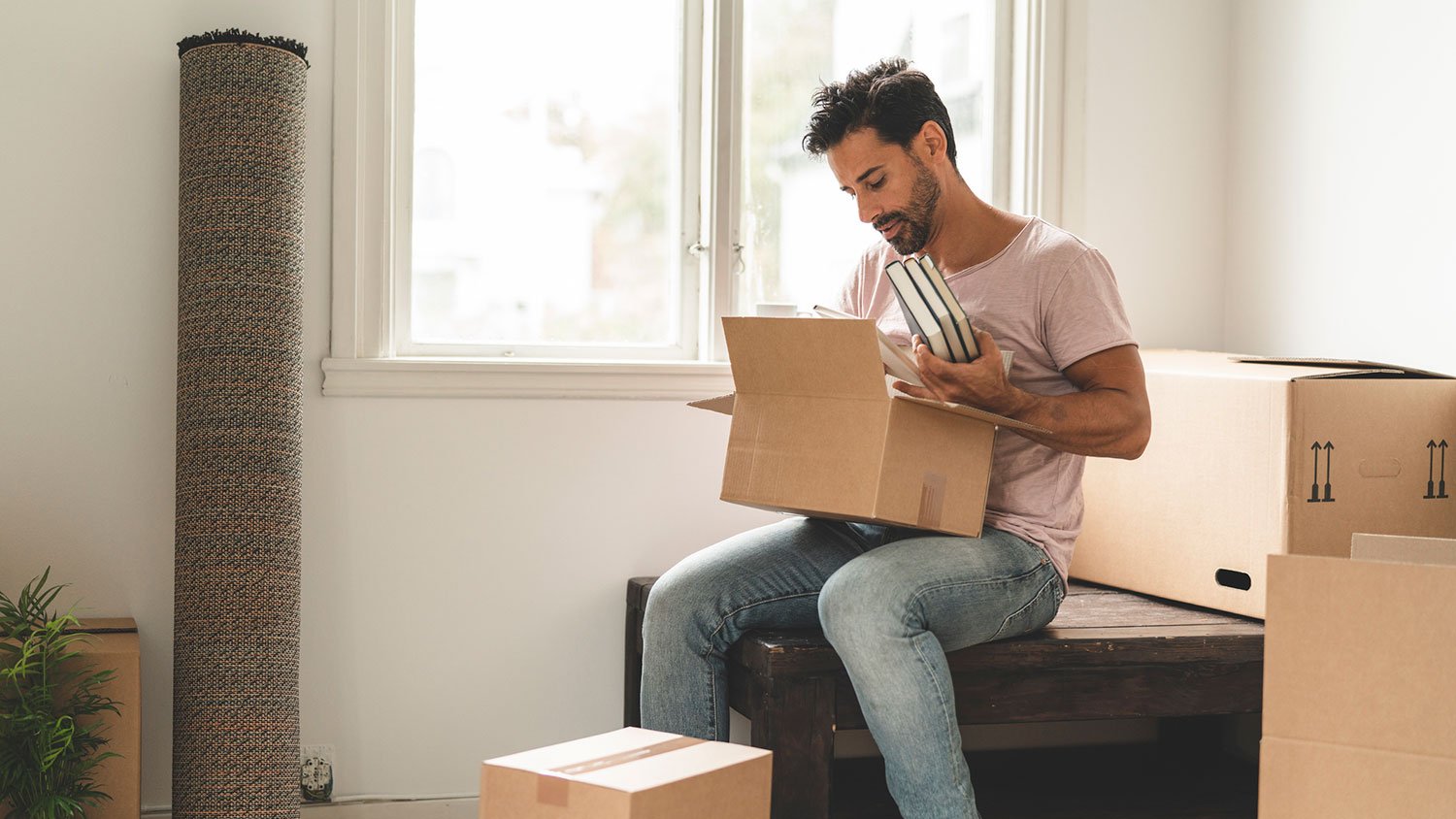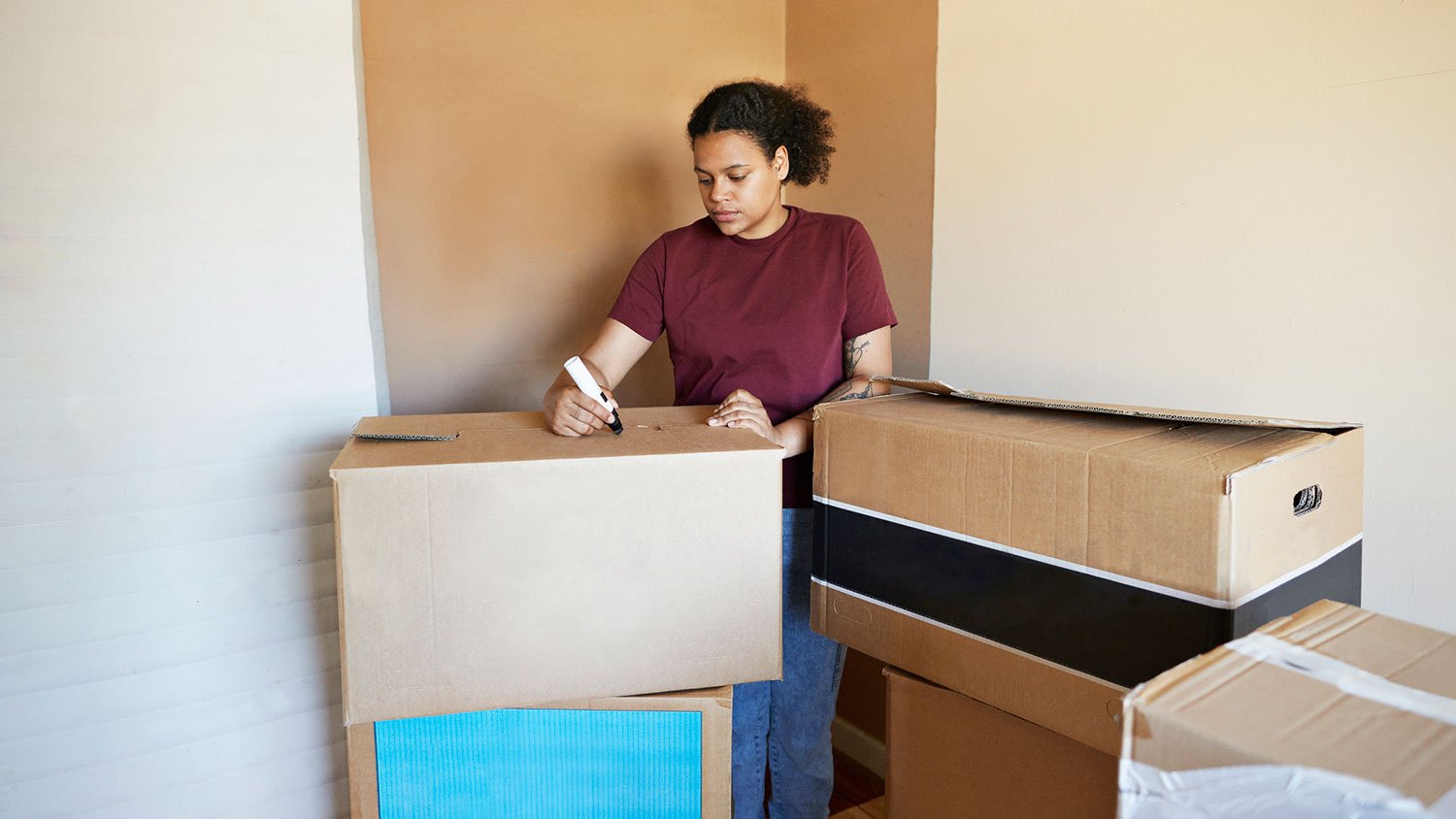How to Pack For a Move: The Best Ways to Tackle Packing While Moving
Let’s get down to the business of packing


Whether it’s your first time moving or your tenth, one thing remains the same—packing your whole house can be a daunting task. But with some planning and prioritizing, you can streamline your packing and focus on your next big step—moving day. Here’s how to pack for a move like a pro in a few simple steps.
Why Do I Need to Create a Packing Plan for My Move?
Picture this not-ideal scenario: You’ve unloaded the moving truck and moved into your new home, only to discover you can’t find the pots and pans to make dinner. By creating a detailed packing plan with notes on the current and future location of each item, you’ll be able to find everything you need after unpacking.
A packing plan also makes packing up your items more efficient because you’ll know exactly how many moving boxes and other supplies you’ll need. Start your move on the right foot by creating a packing plan to keep you organized.
How to Prepare to Pack for Your Move
Save yourself time and money by getting rid of items you don’t love or use regularly. You’ll be happy you did when it’s time to wrap and box all of your items. Make a plan to donate unwanted items or sell household goods to avoid paying for long or short-term storage of unwanted belongings. Once you’ve pared down your belongings, it’s time to start the packing process.
How to Pack for a Move
Let’s dive into the best ways to pack up your home for a move.
Collect DIY Moving Supplies

Consider using a mix of recycled and new moving supplies for a DIY move. You’ll save money and reduce waste by recycling packing materials for more than one move. Consider these supplies an ideal moving-starter kit:
Packing paper, packing peanuts, or bubble wrap
Heavy-duty packing tape
Plastic bags
Trash bags
Thick markers for labeling
Utility knife and scissors
Stretch plastic wrap
Gather an Assortment of Moving Boxes
Of course, the most important component of a move is moving boxes. Start your quest to find moving boxes early to avoid last-minute shopping. You can buy boxes from hardware stores and moving companies, but to cut your costs, search for free boxes at grocery and liquor stores, department stores, big-box stores, and office supply shops.
It’s essential to collect a wide variety of moving boxes. A good mix of moving boxes includes:
A selection of sturdy, small, medium, large and extra-large boxes
Wardrobe boxes
Dish boxes
Boxes with individual cells
Mattress boxes
Artwork and mirror boxes
Make sure your boxes are sturdy and have closable flaps. Reinforce the bottom seams with packing tape. You should also add layers of packing material to the bottoms of the boxes used for breakables to avoid damage from drops, overstacking, and moisture.
Pack Non-Essential Items Early

Sometimes the most challenging part of packing is knowing where to start. Pick a corner of each room for workspace and box the items you aren’t using daily. Most often, you can make headway if you pack:
Out of season items like holiday decorations or summer clothing
Decorating items
Books
Collectibles
Keepsakes
Wrap Items With Care
When you’re moving, it's the tried-and-true packing tips and tricks that help you make speedy progress and protect fragile items from damage.
Max out your boxes at 50 pounds or less. The heavier they are, the more likely they’ll bottom out.
Don’t overstuff your boxes because a bulging box can topple over during transit.
Ask your movers if you can leave clothes in the dressers. Some companies will plastic wrap the drawers shut.
Leave your hanging clothes on the hangers and drop them directly into wardrobe boxes.
Wrap each breakable item individually, like you would a gift. Then, bundle three to five pieces and wrap more paper around the entire bundle.
Load the bundles on their sides (like files) into the box. Dishes laid flat break easier.
Place glasses and stemware rim side down at the top of boxes if you don't have packs with built-in cells.
Wrap frames and art in heavy packaging paper and bubble wrap.
Use specialty mirror boxes.
Reuse the original TV boxes to pack your TV. If you don’t have it, you can use mirror boxes.
Place small appliances in paper and bubble wrap, then secure them in boxes only slightly larger than the item.
Pack Unused Rooms First
It’s easier for some homeowners to start packing the rooms they use least and then tackle the most used rooms closer to move-out day. If you have any of these rooms or spaces in your house, you can make big strides toward moving day by packing them first.
Garage
Shed
Attic
Crawl space
Guest room
Closets
Label Boxes With Your Essentials

Since the last box loaded is typically the first one unloaded, fill those boxes with items you’ll need right away, like toiletries, towels, dinner plates, utensils, and cleaning supplies. It’s also a good idea to toss in the “small-parts bags” with screws, nuts, and bolts for beds and other need-to-have furniture.
Pack computer cables and TV remotes together and label everything, so you know which cords go with which items. Don’t forget to take pictures of your electronics and computer connections when packing your computer for a move.
Keep Your Valuables With You and Check the “Don’t Pack” List
There are certain items that you should avoid packing in the moving truck because they’re sentimental, irreplaceable, or potentially dangerous. First, ask your moving company about household items not to pack. Then, double-check that these everyday items haven’t made their way into the moving boxes.
Cash, cell phone, tablets
Family photos
Prescription medicine
Moving documents
Valuable collections
Legal documents
Financial papers
Flammable household items
Propane containers
Chemicals
Fireworks
Oxygen bottles
Firearms
Things to Keep in Mind for Packing Each Room of the House
Packing can be stressful, and it’s easy to forget last-minute task in the midst of the moving rush. Don’t forget to check these tasks off your list as you’re packing each room.
Kitchen
Before packing away pantry staples and pack up fragile glassware, make sure you have an action plan for tackling the kitchen.
Wrap dry goods in packing paper or bubble wrap before packing them in a box.
For small appliances, tape the cord to the appliance. Place small parts in a sealable bag and tape that to the appliance, too.
Use a glassware with interior sections to safely pack glassware and wine or liquor bottles.
Pack dishes carefully with packing paper and bubble wrap, taking care not to overstuff a box with dishes.
Start defrosting the fridge and freezer at least 48 hours before moving day.
Pack cold food in a cooler with ice or ice packs.
Dining Area
There are a few things to do in the dining room prior to moving to prevent damage to your dining furniture and decor.
Disassemble dining room chairs and table legs, if possible. Place screws and other parts in sealable bags with labels, and keep parts with their piece of furniture.
Wrap the dining tabletop in a packing blanket or in regular blankets.
For china cabinets, remove the glass and wooden shelves or doors and wrap them in packing blankets or bubble wrap.
Wrap the rest of the china cabinet tightly in packing blankets and bubble wrap.
Pack up rugs with using rope or heavy-duty string.
Bathroom
Pack up your bathroom wisely so you don’t spend hours digging through boxes for your shampoo in your new home. Pack bathroom toiletries in a box, label it, and make sure it’s packed in a personal vehicle or toward the door of the moving truck for easy access.
Living Room
In living rooms and other entertainment areas, there are electronics and accompanying cords to pack, plus large furnishings.
Organize and label cords and keep them close to the appropriate devices.
Pack TVs and other electronics in packing blankets, and ask at least two people to carry these heavier items.
Remove furniture legs, if possible, and attach furniture sliders to furniture bases and legs.
Take light bulbs out of lamps and light fixtures, and then wrap them and pack them separately or in their original packaging.
Pack books and DVDs in small boxes.
Bedrooms
Once you get into your new home, you’ll probably be ready for a nap. Make sure bedroom items are organized and packed well for quick, convenient access.
Protect mattresses by wrapping them in a mattress bag.
Put bedding and linens in trash bags, then pack them into the moving boxes to keep them clean.
Pack clothes in trash bags and/or moving boxes, or invest in wardrobe boxes.
Keep jewelry, office files, and other valuables in safes or lockboxes.
How to Overcome Issues that Arise While Moving
While making a detailed packing plan is helpful, some things are just out of your control. Here’s how to deal with some common issues that may arise during the move.
Bad Weather
“Rain, rain, go away!” If this old adage worked. But alas, sometimes, you’re stuck with rain, snow, or other poor weather on moving day. Be prepared for all types of weather:
Take breaks as needed to avoid hurting yourself or damaging your items.
Wear sunscreen, rain or shine.
Wear shoes with good traction to prevent slips or falls.
Check the weather and dress comfortably. It’s a good idea to wear light layers that you can remove or add throughout the move.
Cover cardboard boxes with tarps or plastic bags if it’s raining or snowing.
If you’re driving the moving truck, drive carefully, especially during stormy, rainy, or foggy conditions.
New Home Isn’t Ready
Maybe your new home still needs finishing touches or the previous owners still have the keys. If possible, map out a plan in advance to get the keys and have any work that needs completing done well before your moving day.
But if your new home isn’t ready, arrange to stay with nearby family or friends or book a hotel. If you can’t get into your new home for several days, consider renting short-term portable storage or a storage unit to keep your belongings safe.
Missing or Damaged Items
Unfortunately, accidents can happen during the moving process. Follow these guidelines to reduce the risk of missing or damaged items.
Minimize the risk of losing items with scannable, trackable QR labels. These connect to a smartphone app so you can keep items organized and track them if they get lost.
Wrap and pack your furniture and valuables carefully.
Document the condition of items prior to packing with pictures and detailed descriptions.
DIY Vs. Hire a Pro
Packing for a move yourself is often less expensive than hiring professional movers near you to pack and unpack your items for you, but it can be more stressful. The cost to hire movers to pack your belongings is about $1,000, plus the cost to load the truck and deliver your items to the new home. In total, full-service movers typically charge about $2,300.
FAQs
Check out these answers to common questions about packing for a move.
How far in advance should I pack for a move?
You should start prepping to pack, like gathering moving boxes and decluttering your home, about six weeks before the move. Then, it’s best to start packing at least three weeks before the moving truck arrives.
How should I pack a moving truck?
When it’s time to load furniture and moving boxes into the moving truck, start by bringing on the heaviest items first. Furniture, appliances, and other large and heavy objects should go in first so they don’t crush smaller items. Then, place lighter, smaller items on top of the heavier items instead of trying to fit them into the nooks and crannies beneath larger items.















